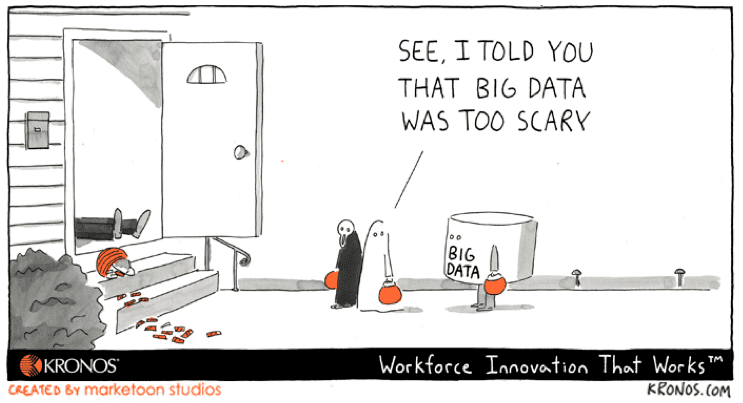Dirty data leads to costly mistakes. Here's how to prevent them
A co-worker once told me the sort of horror story that causes marketers to wake up in a cold sweat in the middle of the night.
In a previous position at a large technology company, he and his team generated numerous leads through conferences and trade shows. The field marketing managers would send the leads to their marketing operations team via CSV files, and the operations team would use the information to follow up with these leads. The data came in varied formats and was not always clean or easily segmented.
In one unfortunate case, the marketing operations team mistakenly uploaded a file containing 500 software industry leads under the service provider category in their system. The leads were routed into the service provider channel, and all 500 of them received a service provider newsletter rather than a software email. Needless to say, the company suffered high unsubscribe rates among one of its most valuable segments.

The scariest thing about this scenario is that it was not a freak accident. Businesses make similar missteps all the time because of dirty data. As marketing becomes increasingly reliant on data, companies have started to realize it’s time to clean house.
Defining Dirty Data
Dirty or unclean data is loosely defined as poorly entered, yielding inaccurate records; improperly maintained, leading to out-of date information; non-normalized, leading to redundancy; loaded with misspelled names or spam traps, or lacking lead sources. Unclean data is a legitimate nightmare to navigate, and it often cripples demand-generation initiatives.
While the drawbacks might seem apparent, dirty data is rampant. Twenty-five percent of the average business-to-business database is inaccurate, according to a study by Sirius Decisions, and 60 percent of businesses reported “unreliable” data health. There are several causes of this troubling trend.
The first problem involves outdated lists. B2B marketers often buy email information for prospects who fit certain criteria, such as industry, job title, or location. These lists might be clean when you buy them, but their value degrades quickly. You might have the names, job titles, corporate email addresses, and revenue brackets for hundreds of prospects, but any of those details could become inaccurate within a matter of months as people change jobs or move.
Similarly, lists that contain spam trap email addresses have contributed to the deluge of unclean data. Organizations use spam traps to expose illegitimate senders and marketers who use poor permission standards. Accidentally emailing a spam trap damages your reputation and that of your email service provider, both of which could increase your bounce rates. Even worse, hitting a spam trap run by a prominent internet service provider could cause your entire domain to be blacklisted.
Finally, major problems can crop up when your data is not standardized. A number of contacts might have similar jobs but use different titles, such as SEO manager, search marketing manager, and specialist. If you don’t clean up the data to include more standardized job titles, you can’t create a segment based on those titles.
The Repercussions of Unclean Information
While nightmare scenarios of sending the wrong email to a massive client list are certainly possible — my colleague can attest to that — plenty more commonplace issues stem from dirty data.
- It stops the execution of great ideas: Perhaps you want to re-engage prospects who signed up for a trial but never became actual users. You recently released some significant enhancements to your product, so it feels like the perfect opportunity to reconnect. If you’re working from messy, inaccurate lists, you won’t be able to segment out these users and target them effectively.
- It hinders lead-scoring efforts: Good demographic, technographic, and behavioral information ensures that your sales team receives quality leads. Without knowing which pages people visit, how they’re engaging with your brand on social media, and whether they have opened your emails, it’s impossible to accurately score your leads. Many B2B buyers say vendor response times factor heavily into their purchase decisions. If you can’t warm leads and pass them along to your sales team in a timely manner, you’ll lose opportunities and revenue.
- It prevents personalization: B2B buyers demand personalization and want to know exactly how a product will benefit them. Unclean data obscures important details such as the challenges leads are facing or what already is in their technology stacks. Considering that 64 percent of respondents in a recent study said vendor knowledge of their companies were “very important” to the buying process, you can’t afford to miss this information.
Cleaning Up Your Database
Given the clear drawbacks, hopefully you’re feeling sufficiently spooked by dirty data. Let’s consider a few tactics to clean up your information and maintain a tidy database moving forward.
- Standardize your processes. As your database grows, know the source of your information. Establish your minimum deliverability rate and ensure your providers can meet this standard. Limit database access to a handful of people to minimize the risk of contamination. Determine which staff members will be responsible for updating and appending data on each team, and separate each department’s processes so their reports don’t interfere with one another.
- Set a baseline. Once you’ve created your standards, gather a baseline understanding of your situation. You can’t plan ahead or mitigate problems if you don’t know where you stand. Conduct a data health check to spot incomplete records and spam traps before you launch any new campaigns. You can run the check in-house or hire a reputable outside vendor to handle it for you.
- Enrich your dataset. Work with third-party data providers to take a holistic view of buyers’ interests and intentions. Data capture mechanisms such as forms on your website don’t provide adequate information to qualify your leads. Third-party tools can enrich your data with additional fields and will help automate data clean-up and standardization. Our company collects a number of leads via forms on our website and various social networks through our own social demand generation system before using Clearbit and Openprise to enrich and streamline that information. Google Analytics and Oktopost then interface with our marketing automation system to help us track how these leads engage with our brand online.
- Add social data to lead records. Social data gives you real-time, accurate insights on your leads. Twitter, Facebook, LinkedIn, and other social platforms tell you which topics interest your leads and which influencers have earned their trust. Combined with the data enrichment strategies mentioned above, social data offers powerful ways to tailor your lead-scoring and nurturing initiatives and can help you accelerate leads through the pipeline.
Dirty data is a constant risk for marketers, so you must be vigilant. If you don’t want to end up like my colleague’s former team and send the wrong message to 500 high-quality leads, invest in data cleanup as soon as possible. When it comes to your company’s data, cleanliness truly is next to godliness.

Thanks to Aseem for sharing their advice and opinions in this post.
Aseem Badshah is the founder and CEO of
Socedo, a demand generation system that helps marketers discover, engage, and qualify leads through social media to increase revenue at scale. Aseem has been a leader in the social media marketing space for more than eight years. Before Socedo, Aseem founded
Uptown Treehouse, a marketing agency for Fortune 500 brands focused on social media.




 Thanks to Aseem for sharing their advice and opinions in this post.
Thanks to Aseem for sharing their advice and opinions in this post. 


